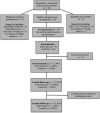Efficacy Study of a Social Communication and Self-Regulation Intervention for School-Age Children With Autism Spectrum Disorder: A Randomized Controlled Trial
- PMID: 31287766
- PMCID: PMC7838961
- DOI: 10.1044/2019_LSHSS-18-0093
Efficacy Study of a Social Communication and Self-Regulation Intervention for School-Age Children With Autism Spectrum Disorder: A Randomized Controlled Trial
Abstract
Purpose This study aimed to examine the initial efficacy of a parent-assisted blended intervention combining components of Structured TEACCHing and Social Thinking, designed to increase social communication and self-regulation concept knowledge in 1st and 2nd graders ( n = 17) diagnosed with autism spectrum disorder (ASD) and their parents. Method A randomized delayed treatment control group design with pre- and postintervention assessments of both parents and children was implemented within a community practice setting. Two follow-up assessments at 3 and 6 months postintervention were also completed. Results Overall, results indicate that the intervention is efficacious in teaching social communication and self-regulation concept knowledge to children with ASD and their parents. Both parents and children demonstrated an increase in social communication and self-regulation knowledge after participating in the Growing, Learning, and Living With Autism Group as compared to a delayed treatment control group. The effects of the intervention did not extend to parent-child interactions coded from video recordings. Child treatment effects were maintained at the 3- and 6-month follow-up assessments. Conclusions Preliminary efficacy of the Growing, Learning, and Living With Autism Group was established. Based on parent report at the conclusion of the intervention, this is a socially valid intervention for teaching social communication and self-regulation skills to school-age children with ASD. Supplemental Material https://doi.org/10.23641/asha.8637236.
Figures
Similar articles
-
Paediatric Autism Communication Therapy-Generalised (PACT-G) against treatment as usual for reducing symptom severity in young children with autism spectrum disorder: study protocol for a randomised controlled trial.Trials. 2018 Sep 21;19(1):514. doi: 10.1186/s13063-018-2881-3. Trials. 2018. PMID: 30241574 Free PMC article.
-
Effects of Parent-Implemented Early Start Denver Model Intervention on Chinese Toddlers with Autism Spectrum Disorder: A Non-Randomized Controlled Trial.Autism Res. 2018 Apr;11(4):654-666. doi: 10.1002/aur.1917. Epub 2018 Feb 7. Autism Res. 2018. PMID: 29412514 Clinical Trial.
-
Rationale and design for cognitive behavioral therapy for anxiety disorders in children with autism spectrum disorder: a study protocol of a randomized controlled trial.Trials. 2018 Apr 2;19(1):210. doi: 10.1186/s13063-018-2591-x. Trials. 2018. PMID: 29609630 Free PMC article.
-
Parent-Mediated Interventions for Children With Autism Spectrum Disorder: A Systematic Review.Am J Occup Ther. 2019 May/Jun;73(3):7303205010p1-7303205010p13. doi: 10.5014/ajot.2019.030015. Am J Occup Ther. 2019. PMID: 31120831
-
Computer- and Robot-Assisted Therapies to Aid Social and Intellectual Functioning of Children with Autism Spectrum Disorder.Medicina (Kaunas). 2019 Aug 5;55(8):440. doi: 10.3390/medicina55080440. Medicina (Kaunas). 2019. PMID: 31387274 Free PMC article. Review.
Cited by
-
Association of Parental Support with Reduced Stereotypy in Children with Autism Spectrum Disorder: A Cross-Sectional Study.Medicina (Kaunas). 2023 Sep 15;59(9):1667. doi: 10.3390/medicina59091667. Medicina (Kaunas). 2023. PMID: 37763786 Free PMC article.
-
The suitability and acceptability of a co-designed prototype psychoeducational activity book for autistic children aged five-eleven years.Autism Dev Lang Impair. 2024 Feb 28;9:23969415241234648. doi: 10.1177/23969415241234648. eCollection 2024 Jan-Dec. Autism Dev Lang Impair. 2024. PMID: 38426035 Free PMC article.
-
Australian School Staff and Allied Health Professional Perspectives of Mental Health Literacy in Schools: a Mixed Methods Study.Educ Psychol Rev. 2023;35(1):3. doi: 10.1007/s10648-023-09725-5. Epub 2023 Jan 21. Educ Psychol Rev. 2023. PMID: 36712917 Free PMC article.
-
The effectiveness of applied behavior analysis program training on enhancing autistic children's emotional-social skills.BMC Psychol. 2024 Oct 17;12(1):568. doi: 10.1186/s40359-024-02045-5. BMC Psychol. 2024. PMID: 39420428 Free PMC article.
-
Is There a Bias Towards Males in the Diagnosis of Autism? A Systematic Review and Meta-Analysis.Neuropsychol Rev. 2025 Mar;35(1):153-176. doi: 10.1007/s11065-023-09630-2. Epub 2024 Jan 29. Neuropsychol Rev. 2025. PMID: 38285291 Free PMC article.
References
-
- American Psychiatric Association. (2013). Diagnostic and statistical manual of mental disorders (5th ed., DSM-5). Washington, DC: Author.
-
- Anderson D. K., Liang J. W., & Lord C. (2014). Predicting young adult outcome among more and less cognitively able individuals with autism spectrum disorders. The Journal of Child Psychology and Psychiatry, 55, 485–494. https://doi.org/10.1111/jcpp.12178 - PMC - PubMed
-
- Baio J., Wiggins L., Christensen D. L., Maenner M. J., Daniels J., Warren Z., … Dowling N. F. (2018). Prevalence of autism spectrum disorder among children aged 8 years—Autism and developmental disabilities monitoring network, 11 sites, United States, 2014. MMWR Surveillance Summaries, 67, 1–23. - PMC - PubMed
-
- Barnard-Brak L., Brewer A., Chesnut S., Richman D., & Schaeffer A. M. (2016). The sensitivity and specificity of the Social Communication Questionnaire for autism spectrum with respect to age. Autism Research, 9(8), 838–845. - PubMed
-
- Barnhill G. P. (2001). Social attributions and depression in adolescents with Asperger syndrome. Focus on Autism and Other Developmental Disabilities, 16(1), 46–53.
Publication types
MeSH terms
LinkOut - more resources
Full Text Sources
Medical



